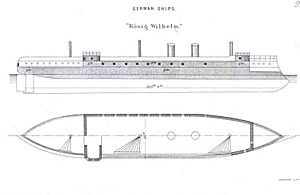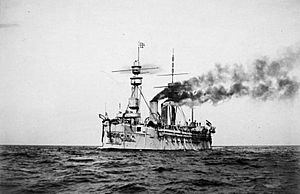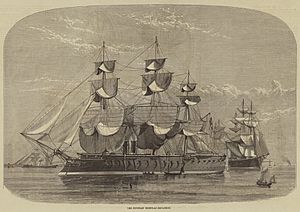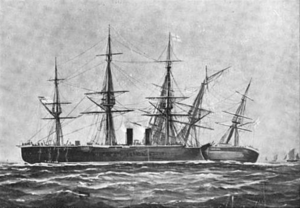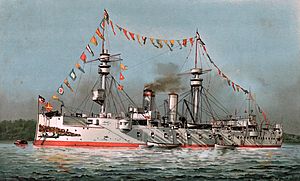SMS König Wilhelm facts for kids
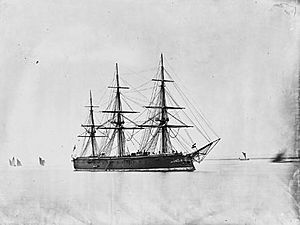
König Wilhelm in Gravesend, England
|
|
Quick facts for kids Class overview |
|
|---|---|
| Operators: |
|
| Preceded by: | Kronprinz |
| Succeeded by: | Hansa |
| History | |
| Name | SMS König Wilhelm |
| Namesake | Wilhelm I, King of Prussia |
| Builder | Thames Iron Works, Leamouth, London |
| Laid down | 1865 |
| Launched | 25 April 1868 |
| Commissioned | 20 February 1869 |
| Stricken | 4 January 1921 |
| Fate | Broken up, 1921 |
| General characteristics (as built) | |
| Type | Armored frigate |
| Displacement | |
| Length | 112.2 m (368 ft 1 in) |
| Beam | 18.3 m (60 ft) |
| Draft | 8.56 m (28 ft 1 in) |
| Installed power | |
| Propulsion | |
| Sail plan | 2,600 m2 (28,000 sq ft) |
| Speed | 14 knots (26 km/h; 16 mph) |
| Range | 1,300 nmi (2,400 km; 1,500 mi) at 10 knots (19 km/h; 12 mph) |
| Crew |
|
| Armament |
|
| Armor |
|
SMS König Wilhelm (which means King William) was a powerful armored frigate. It served in the Prussian Navy and later the German Imperial Navy. The ship was started in 1865 in London, England. It was originally meant for the Ottoman Empire and called Fatih. Prussia bought it in 1867. It was launched in 1868 and joined the Prussian Navy in 1869.
For a while, König Wilhelm was the biggest and strongest warship in the German navy. It was the main ship, or flagship, during the Franco-Prussian War (1870–1871). However, engine problems kept it from fighting much. In 1878, the ship accidentally crashed into and sank another armored ship, Grosser Kurfürst. Many lives were lost in that accident.
König Wilhelm was later changed into an armored cruiser in 1895–1896. By 1904, newer ships had been built, so it was no longer the most modern. It was then used as a floating home for sailors and a training ship. It kept this role even through World War I. In 1921, after serving for 52 years, the ship was taken apart for scrap metal.
Contents
Building the Ship: Design and Features
König Wilhelm was first ordered by the Ottoman Empire in 1865. It was built at the Thames Ironworks and Shipbuilding Company in London. A British naval architect named Edward James Reed designed it. At the time, people thought it was one of the most powerful ships in the world. It was even larger than the British ship HMS Hercules and carried more guns.
However, the Ottoman Empire could not pay for the ship. So, the builders put the unfinished ship up for sale. The Kingdom of Prussia wanted to get more ironclad warships. They had already ordered two ships from British and French shipyards in 1865. When Fatih became available, Prussia decided to buy it for their navy. Prussia had struggled against a Danish naval blockade in an earlier war (1863–1864). They wanted strong ironclads to prevent future blockades.
When it joined the Prussian fleet, König Wilhelm was the biggest and most powerful ship. It served as the fleet's flagship. It remained the largest German ship until 1891. This was partly because Germany built only one small ironclad between 1876 and 1888. The four Brandenburg-class battleships, launched in 1891 and 1892, were the first ships to be larger than König Wilhelm.
Ship's Size and How it Moved
König Wilhelm was about 112.2 m (368 ft 1 in) long overall. It was 18.3 m (60 ft) wide and went 8.56 m (28 ft 1 in) deep into the water. The ship was designed to weigh about 9,757 metric tons (9,603 long tons) when normally loaded. It could weigh up to 10,761 t (10,591 long tons) when fully loaded. The ship's body, or hull, was made with iron frames. It had eleven watertight compartments. This helped prevent the ship from sinking if one part was damaged.
The German navy said König Wilhelm handled well at sea. It responded quickly to steering commands. It rolled a lot in rough seas but did not pitch much (move up and down at the ends). A single rudder helped steer the ship. The ship's crew included 36 officers and 694 enlisted men. When it was the flagship, it had an extra command team of 9 officers and 47 men. The ship also carried smaller boats, like picket boats and launches.
A large two-cylinder single-expansion steam engine powered the ship. It turned a four-bladed screw propeller that was 7 m (23 ft) wide. Eight large boilers made the steam for the engine. These boilers were in two separate rooms, each with its own funnel to let out smoke.
The engine was designed to produce 8,000 metric horsepower (7,900 ihp) of power. This gave the ship a top speed of 14 knots (26 km/h; 16 mph). During tests, König Wilhelm actually went faster, reaching 14.7 knots (27.2 km/h; 16.9 mph). The ship could carry 750 t (740 long tons) of coal. This allowed it to travel about 1,300 nautical miles (2,400 km; 1,500 mi) at a speed of 10 knots (19 km/h; 12 mph). The ship also had a ship rig with sails. These sails covered an area of 2,600 square meters (28,000 sq ft), but they did not add much to the ship's speed.
Guns and Protection
When it was first built, König Wilhelm had 33 large 72-pounder cannons. After it was delivered to Germany, these guns were replaced. It then had eighteen 24-centimeter (9.4 in) L/20 guns. These were placed in a central area, with nine on each side. These guns could shoot targets up to 4,500 m (14,800 ft) away. The ship also had five smaller 21 cm (8.3 in) guns. These could shoot up to 5,900 m (19,400 ft).
The ship was protected by thick wrought iron plates. These plates were placed over a teak wood backing. The thickest armor was in the middle of the ship, near the waterline. Here, the iron armor was 305 mm (12 in) thick on the outside and 178 mm (7 in) thick on the inside. Behind the iron was 250 mm (9.8 in) of teak wood. The main guns were protected by 150 mm (5.9 in) thick plating.
Changes Over Time
König Wilhelm was rebuilt into an armored cruiser between 1895 and 1896. During this time, its weapons were updated. It received twenty-two 24 cm L/20 guns. It also got one 15 cm (5.9 in) L/30 gun at the back and eighteen 8.8 cm (3.5 in) quick-firing guns on the upper deck. Five 35 cm (14 in) torpedo tubes were also added. These could fire torpedoes from the front, sides, and back of the ship.
During this rebuild, the old iron armor was removed. It was replaced with stronger steel armor. The conning tower, where the ship was controlled, also received armor protection. After it became a training ship, most of its weapons were removed. By 1915, it only carried a few 8.8 cm guns.
Ship's Life: Service History
König Wilhelm was started in 1865. Prussia bought it on February 6, 1867. It was first called Wilhelm I, but its name was changed to König Wilhelm on December 14. It was launched on April 25, 1868. After being completed, it joined the navy on February 20, 1869. Its first commander was Ludwig von Henk. Soon after, it joined other armored ships for training in August and September.
Franco-Prussian War (1870–1871)
In May 1870, König Wilhelm and other ships visited Britain. However, one ship was damaged, and tensions with France were rising. The ships learned that war was likely. They cut their trip short and returned home.
They arrived back in Wilhelmshaven on July 16, just three days before France declared war on Prussia. This started the Franco-Prussian War. The Prussian Navy was much smaller than the French Navy. So, it focused on defending its coast from a French naval blockade. König Wilhelm and other ships gathered in Wilhelmshaven. They hoped to break the French blockade there.
The German ships, led by Vice Admiral Eduard von Jachmann, sailed out in early August 1870. They went to the Dogger Bank but did not find any French warships. König Wilhelm and the other large ships then had engine problems. This left a smaller ship, Arminius, to do most of the work. By September 11, the big ships were ready again. They went on another mission into the North Sea. Again, they did not find any French ships, as the French Navy had already returned home.
Peacetime Operations in the 1870s
After the war, the Prussian Navy became the Imperial Navy. It went back to its normal training routines. General Albrecht von Stosch was in charge of the navy. He organized the fleet for coastal defense. In the early 1870s, König Wilhelm and other armored frigates were used off and on. They would train in the summer and then be put away for the winter.
For the 1875 training year, König Wilhelm sailed with other new ironclads. They stayed in local waters. König Wilhelm was not used in 1876 and 1877.
König Wilhelm was brought back into service in early 1878 for training. On May 31, while sailing in the Straits of Dover, König Wilhelm accidentally crashed into a new ship, Grosser Kurfürst. The two ships, along with Preussen, had left Wilhelmshaven a few days earlier.
König Wilhelm and Preussen were sailing in a line, with Grosser Kurfürst to their right. They saw two sailing boats. Grosser Kurfürst turned left to avoid the boats. König Wilhelm also tried to pass the boats. But there was not enough space between König Wilhelm and Grosser Kurfürst. König Wilhelm turned sharply left to avoid Grosser Kurfürst. However, it was too late. König Wilhelm's pointed front, called a ram bow, tore a hole in Grosser Kurfürst.
Water quickly filled Grosser Kurfürst. The ship sank in about eight minutes. Out of 500 crew members, 269 died in the accident. König Wilhelm was also badly damaged. Its front part was flooding. The captain first thought about steering the ship onto the beach to stop it from sinking. But he realized the ship's pumps could handle the water. The ship then went to Portsmouth for temporary repairs. This allowed it to return to Germany. On the way back, it had another small collision with a British fishing boat.
After the crash with Grosser Kurfürst, the German navy held a special court hearing. They investigated the accident. König Wilhelm needed long repairs from 1878 to 1882. The work was done at the Imperial Dockyard in Wilhelmshaven. Its guns were also updated to all be the same size.
Later Service and Retirement
From 1885 to 1897, the ship had special nets added to protect against torpedoes. König Wilhelm returned to service in 1887. It took part in ceremonies for the start of the Kaiser Wilhelm Canal. This canal was built to connect Kiel with the North Sea. The ship continued to train in the summers. It also participated in training in 1888. It was not active from 1889 to late 1892. But it was reactivated for a training trip in the winter of 1892–1893.
By 1893, König Wilhelm was the flagship for the Second Division of the German fleet. It was based in Wilhelmshaven. On February 20, 1894, a special ceremony was held on the ship. It celebrated 25 years since the ship was first used. The German Emperor, Wilhelm II, attended.
In April 1894, the Second Division went on a training trip. During this trip, König Wilhelm got stuck on a mud bank. Other ships quickly pulled it free with little damage. The ships then sailed to Scotland. They returned to Kiel for supplies before summer exercises. In the 1894 exercises, König Wilhelm's division pretended to be a Russian fleet attacking Germany's Baltic coast.
In 1895, König Wilhelm went to a shipyard in Hamburg for a big rebuild. It was changed into an armored cruiser. Its weapons were increased, and its sails were removed. New, stronger masts were put in place. The ship's crew size also grew a lot. The work finished in 1896, and the ship returned to the fleet on January 25, 1897. On June 26, it represented Germany at a special event for Queen Victoria's Diamond Jubilee.
The ship served with the fleet until 1904. Then, it was taken out of active duty. Starting on May 3, 1904, it became a harbor ship. From October 1, 1907, it was used as a barracks ship and training vessel for young naval cadets in Kiel. Two years later, König Wilhelm moved to the Naval Academy at Mürwik. It continued its training duties there. It served through World War I. On January 4, 1921, the ship was officially removed from the navy list. It was then broken up for scrap metal in Rönnebeck.


